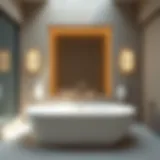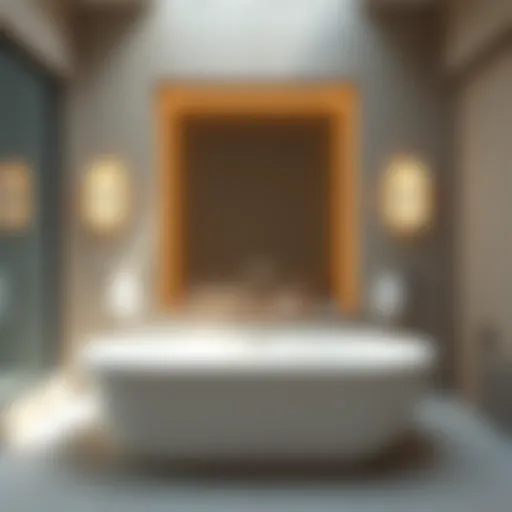Elevate Your Bathroom with Wainscoting Techniques
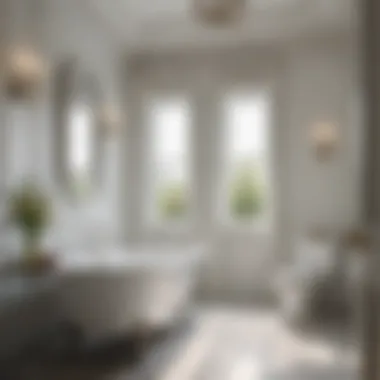

Intro
Bathroom remodeling can often feel like a daunting task. However, when it comes to incorporating wainscoting, it opens up a world of possibilities for both aesthetic improvement and functional enhancement. The use of wainscoting has long been associated with elegance and sophistication. It's not just about style; it offers durability and versatility tailored specifically for the nuances of a bathroom environment. This guide aims to delve into the practical aspects of bathroom remodeling with wainscoting, focusing on design inspirations and functional elements, and providing homeowners and design enthusiasts with the necessary insights to craft stunning, yet functional spaces.
Design Inspirations
When you start to style a bathroom, the choices can be overwhelming. But, looking at the latest trends and color palettes can simplify this journey.
Latest Trends in Bath and Bedroom Design
Wainscoting has regained popularity recently, thanks to its compatibility with both modern and classic designs. Minimalistic approaches are trending, where clean lines and subtle textures come to play a significant role. Many are opting for a more relaxed look with materials that replicate natural textures. Combined with the right light fixtures, a wainscoted bathroom can become a statement of design.
Color Palettes and Themes
Choosing the right color can make or break a remodeling project. Neutral colors dominate, allowing homeowners to try various accents or fixtures. This simplicity lends itself well to any style of wainscoting. Consider the sophistication of muted navy blue, complemented by crisp white trims.
"The color you choose can transform your space from drab to fab!"
Many enthusiasts are utilizing two-tone colors for their wainscoting, giving depth to their walls. If you want a coastal vibe, think about soft pastels or sandy beiges. On the contrary, darker hues can project warmth and elegance, suitable for those wanting a cozy sanctuary.
Functional Elements
While aesthetics are vital, functionality should never take a backseat. Wainscoting serves both purposes remarkably well.
Space Optimization Tips
An essential aspect to consider in a bathroom remodel is how to maximize your available space. Wainscoting can visually expand the area while creating a defined structure. Implementing built-in shelves with wainscoting provides both style and storage, ensuring you maintain a clean and organized space.
Multi-Functional Furniture Choices
Incorporating multi-functional furniture is key in modern bathroom designs. Look for vanities with storage options or benches that can serve as seating or storage. Think about utilizing wainscoting in the design of these elements. A bench with a wainscoted back can transform your bathroom into a more comfortable and appealing area.
Finding the right balance between style and practicality can lead you to a beautifully remodeled bathroom that you'll want to show off to every guest. Exploring these aspects of wainscoting will not only elevate your bathroom's aesthetic but enhance the overall functionality as well.
Prologue to Bathroom Remodeling
A bathroom remodel is about more than just making the space pretty; it's often about creating a sanctuary where one can unwind at the end of a long day. The stakes are high, and so are the rewards. Owners want their investments to shine, expressing personal taste while ensuring the room serves its purpose well. Bathroom remodeling can significantly enhance the property's value, create a more functional space, and improve daily routines.
When taking a leap into this world of remodeling, it's essential to consider the various aspects involved. From layout changes to material selections to integrating new styles, each decision can either elevate or detract from the intended outcome. Each homeowner has their unique vision, but how they choose to execute that can make all the difference.
Moreover, the bathroom is one of the most visited spaces in a home. It must balance aesthetics, comfort, and functionality. A fresh look with the right touch of elegance can transform an ordinary bathroom into a remarkable retreat.
This is where design elements like wainscoting come into play. Wainscoting is not merely decor; it serves practical purposes—protecting walls from moisture while adding a sophisticated element to the bathroom's overall appearance. Each choice made during a remodel, from materials to finishes, lays the groundwork for the entire project's success.
"Remodeling isn’t just a project; it’s an opportunity to reinvent everyday experiences into something special."
Understanding the Basics of Remodeling
To embark on a bathroom remodel, one must first grasp the basics. Start with a clear idea of the existing layout. Are the fixtures optimally placed? Is there enough space to move around comfortably? Mapping out the current setup helps identify areas for improvement.
Also, it helps to jot down what one needs in the bathroom versus what one wants. This way, priorities are set. Consider functionality as a guiding principle. Bathroom designs should cater to daily routines like hygiene, beauty tasks, and relaxation.
In simple terms, a successful remodel often operates on three basic principles: planning, execution, and finishing touches. Each principle feeds into the next, creating a cohesive workflow that can minimize stress and maximize satisfaction with the results.
Why Wainscoting Matters
Wainscoting goes beyond just being a design element in bathroom remodeling; it encapsulates both style and practicality. This feature originated centuries ago as a way to insulate walls and prevent damage from moisture. Today, it still offers those benefits, along with an aesthetic appeal that’s hard to ignore.
Opting for wainscoting can introduce texture and layers into a space that’s often overlooked. The choices available are impressive—beadboard, flat panel, and raised panel styles can evoke either a classic charm or a modern vibe, depending on the surrounding décor. Each style adds an element of distinction that elevates the space.
Furthermore, maintenance is simplified with wainscoting. The material is easy to clean, which is a huge plus in humid environments like bathrooms. This structural detail can also make the room appear larger than it is, adding visual interest to walls that may otherwise go unnoticed.
For homeowners looking to craft a personalized aesthetic while ensuring durability and ease of care, wainscoting stands out as a practical yet stylish option. Incorporating such elements into a bathroom remodel imbues the space with character, breathing life into bathrooms that could easily fall into monotony.
Exploring Wainscoting Design Options
Why Explore Wainscoting Design Options?
When it comes to bathroom remodeling, it's not just about slapping some paint on the walls and calling it a day. The way a bathroom looks can be an extension of your personality and style. Wainscoting plays a pivotal role here, adding depth, texture, and classic elegance to what could otherwise be a mundane space. Ignoring the design options available to wainscoting could mean missing out on a chance to make a statement that mirrors your taste and lifestyle.
Wainscoting can enhance the aesthetic of any bathroom while also offering practical advantages. It helps protect walls from moisture and damage, and it can add insulation, thereby safeguarding against temperature changes. Plus, when you explore various design options, you also find materials that suit your budget and preferences. Whether it's a rustic beadboard or a modern geometric pattern, each choice speaks volumes about the atmosphere you wish to create.
Classic Styles of Wainscoting
Beadboard Wainscoting
Beadboard wainscoting, with its charming vertical panels, adds an inviting touch to any space. The key characteristic of beadboard is its unique texture; it gives a sense of depth without overwhelming the eyes. This style is often associated with a classic or country feel, making it an excellent choice for those aiming for a cozy, relaxed bathroom environment.
What sets beadboard apart is its ease of installation and versatility. A beneficial choice, beadboard can be painted or stained, allowing for a custom color scheme that matches your decor. However, this material does have its limitations, notably its vulnerability to water damage; thus, applying a good sealant is essential, especially in bathroom settings.
Flat Panel Wainscoting
Moving on to flat panel wainscoting, this style features a clean and straightforward design, consisting of flat boards that can be arranged in various patterns. Its key characteristic is its ability to blend seamlessly with modern design elements. Many homeowners appreciate the minimalist vibe that flat panel wainscoting brings to the table, making it a popular choice for contemporary spaces.
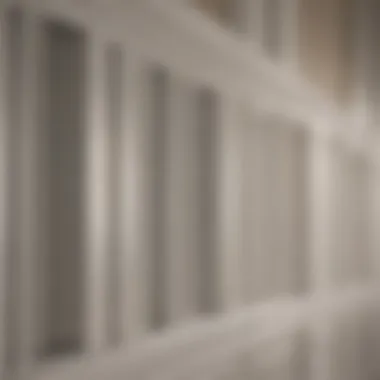

This style offers a unique feature of customization; you can switch out the backing panels as styles change. One downside, however, is that it may not offer the same traditional feeling as other types, which can be a disadvantage if you're seeking a more homey atmosphere.
Raised Panel Wainscoting
Now, let's talk about raised panel wainscoting. This style elevates the game with its more ornate and sophisticated design, which tends to draw attention. The key characteristic is the depth it provides through the raised panels, creating a sense of grandeur. Raised panel styles are often found in high-end bathrooms, and their luxurious appearance can transform an ordinary space into something extraordinary.
The standout feature of raised panel wainscoting is its ability to match various architectural styles, from colonial to modern. However, the downside lies in the price, as this style generally requires more materials and craftsmanship. When done right, it can significantly enhance the elegance of your bathroom.
Modern Interpretations
Geometric Patterns
In recent years, geometric patterns have taken center stage in home design, wainscoting included. These patterns create an edgy and artistic vibe, perfect for avant-garde homeowners. The key characteristic here is the visual stimulation that geometric shapes provide, offering a fresh perspective in spaces that often lean toward traditional aesthetics.
Crisp lines and varying shapes offer the chance to play with colors, turning a simple wainscoting installation into a piece of art. However, it is worth noting that with greater detail comes the potential for higher maintenance. Keeping those patterns clean and fresh can sometimes be a chore.
Shiplap and Other Textures
Finally, shiplap is redefining the face of modern wainscoting. Known for its rustic charm, shiplap offers homeowners a chance to step into a cozy yet chic atmosphere. The key characteristic is its horizontal installation, which makes rooms feel more expansive.
Shiplap is particularly advantageous for its durability. Typically made from treated wood or composite materials, it can withstand moisture better than traditional wooden panels. However, its rustic aesthetic may not suit everyone, and it can sometimes be challenging to match with more contemporary fixtures.
In exploring wainscoting design options, it becomes clear that each style, whether classic or modern, offers unique advantages and opportunities for personal expression in your bathroom.
Selecting Materials for Wainscoting
When it comes to bathroom remodeling, the materials used for wainscoting play a pivotal role in how the space feels and performs. Choosing the right material not only affects the aesthetic quality but also impacts durability, maintenance ease, and moisture resistance – crucial factors in a bathroom environment. A thoughtful selection can elevate an ordinary space into something remarkable, making it vital to consider both beauty and practicality.
Types of Wood for Wainscoting
Wood has long been a popular choice for wainscoting due to its natural warmth and character. The right wood can seamlessly fit into various themes, from rustic to modern. Here are a few types of wood commonly used:
- Pine: Often favored for its affordability, pine is easily workable but might require more maintenance due to its porosity.
- Oak: Known for its strength and stunning grain, oak wainscoting can bring a touch of sophistication to your bathroom, but it can be on the pricier side.
- Maple: This wood has a smooth finish and light color that complements various designs. It's more resistant to dings and dents, making it a practical choice.
- Cedar: Not only does cedar resist moisture well, it also has a pleasant scent. Hence, it’s particularly suited for a bathroom setting.
Choosing wood specifically treated for moisture resistance will help in long-term maintenance, preventing warping or rot. The distinctness of each wood also allows for creative expression, helping you craft a unique bathroom vibe.
Alternative Materials: MDF and PVC
For homeowners looking for budget-friendly options, Medium-Density Fiberboard (MDF) and Polyvinyl Chloride (PVC) are worth considering. These materials have grown popular as alternatives to traditional wood.
- MDF: Made from compressed wood fibers, MDF is strong yet lightweight. It takes paint beautifully, allowing for a wide range of colors. However, while it’s generally resistant to warping, it isn’t waterproof, so it should be used cautiously in areas prone to splashes.
- PVC: This synthetic material boasts high moisture resistance, making it safe for wet environments. It’s easy to install and available in various styles that mimic wood appearance. Maintenance is a breeze because dirt and grime wipe off easily. However, some may find its aesthetics lacking when compared to natural wood.
"Selecting the right material is more than just an aesthetic choice—it’s an investment in the longevity of your design."
When considering materials for wainscoting, think about how each option meets your needs for durability against moisture, budget, and style. Ultimately, the right material choice ensures not just a pretty face, but a functional piece of your redesigned bathroom.
Planning Your Bathroom Remodel
Planning a bathroom remodel is no small feat. It’s one part artistry and two parts practicality. This section underscores that the groundwork you lay now will dictate the success of your entire project. A well-thought-out plan keeps headaches at bay and ensures that each addition, like wainscoting, marries effortlessly with the space you’ve got.
Before rolling up your sleeves, evaluate the current state of your bathroom. Understand what works and what simply has to go. This involves not only assessing the size and layout of your bathroom but also identifying features worth preserving.
Assessing Your Current Space
When it comes to assessing your current bathroom, the goal is to look with fresh eyes. Start by measuring everything. Get to know the dimensions of walls, doors, windows, and plumbing fixtures.
Key Considerations:
- Layout: What’s the flow like? You want to walk in and feel at home, so think about how each part interacts.
- Natural Light: Are there places where light floods in? How will your wallpaper or wainscoting colors reflect that?
- Functionality: Consider how the room is used. Do you need additional storage? Are there adequate outlets for your needs?
Taking all this into account provides you with a clear canvas to work from, while also signaling where enhancements—especially with the inclusion of wainscoting—might play a transformative role.
Creating a Cohesive Design Scheme
A cohesive design scheme makes the bathroom feel like a well-tailored outfit instead of a mismatched ensemble. It means everything works together, instilling a sense of harmony. Here, the aesthetic of wainscoting feeds into this scheme beautifully, tying new elements with the old.
Color Palettes
When it comes to choosing a color palette, think of it as setting the mood. A well selected palette can elevate the vibe of your bathroom, whether you want something tranquil or electrifying. Neutral colors tend to be user-friendly.
- Soft Grays and Whites: These can create an airy feel, especially when used with shiny tiles and fixtures. It’s a popular choice for small spaces.
- Bold Accent Shades: Perhaps navy blue or forest green for warmth against the backdrop of bright faucets and trim. They can give your bathroom a sophisticated quality.
A clever use of color brings out the best in wainscoting, emphasizing its texture and design.
Alignment with Fixtures
The way you align wainscoting with your bathroom’s fixtures can either enhance or detract from the overall aesthetic.
- Fixture Finishes: Chrome and brass fixtures harmonize differently with various styles of wainscoting. For example, polished chrome pairs nicely with a contemporary white wainscoting but can clash with rustic wood tones.
- Height Considerations: How high does your wainscoting go? Think about faucet heights and light switches to ensure you don’t end up painting yourself into a corner.
When fixture alignment is thoughtfully designed, it brings a polished finish to your remodel and elevates that feeling of cohesion. Don't overlook how details can shape your final result.
"Success is where preparation and opportunity meet." - Bobby Unser
Planning your bathroom remodel with a meticulous view allows you to savor the process of transforming your space into something special.
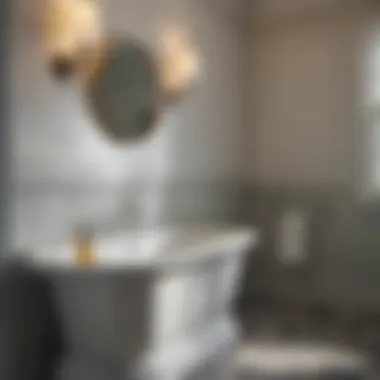

Installation Techniques for Wainscoting
When it comes to bathroom remodeling, wainscoting stands out as a transformative element that enhances both the style and functionality of the space. Understanding the installation techniques is crucial, as it ensures not just a polished appearance but also solid performance against moisture and daily wear. Proper installation impacts the longevity of your wainscoting and ultimately contributes to the overall satisfaction with your renovation.
Whether you’re doing this yourself or hiring a professional, mastering these techniques will arm you with insights that can elevate your bathroom to a different level of sophistication.
Preparation Steps
Tools Required
The right tools are like a craftsman’s best friends; they make the task at hand a smoother experience. You’ll need a good assortment of tools for wainscoting installation to achieve a professional finish. Essential tools include:
- Miter Saw: Ideal for making precise angle cuts.
- Level: Ensures your panels are straight and look good from every angle.
- Nail Gun: Speeds up the installation process, especially for larger projects.
- Tape Measure: For taking accurate measurements which are essential for a good fit.
One of the key characteristics of using a miter saw is its ability to create clean cuts, making it a beneficial choice for intricate designs or corner joints. Meanwhile, a nail gun cuts down on time, but it's crucial to use it correctly to avoid mishaps.
On the downside, tools like the nail gun can be a double-edged sword; if not handled well, they could lead to damage. Prior experience is a plus, or you might want to practice on scrap wood before diving right into your wainscoting project.
Measuring and Cutting
Measuring and cutting are pivotal steps that determine how well the finished project will turn out. Having accurate measurements can save you from unnecessary headaches later on. It's simple: if you measure wrong, you cut wrong. This could lead to wasted materials and extra costs.
When measuring for wainscoting, it’s often best to take multiple measurements at different points on the wall; walls can be quite finicky. Key characteristics of effective measuring include:
- Consistency: Regular re-checking of measurements before cutting.
- Precision: Using precise measurement techniques like marking the points with a pencil.
The uniqueness of cutting comes further into play when you utilize the right tool. For example, a table saw can yield smoother cuts than a hand saw, but working with a hand saw may foster a more hands-on approach that some DIY enthusiasts prefer. Each method has its own pros and cons, depending on your comfort with tools, which can either simplify or complicate your work.
Step-by-Step Installation Process
Following a well-structured installation process not only ensures a successful project but also turns an overwhelming task into a manageable one. The installation can be broken down into essential steps that guide you seamlessly from preparation to finish.
- Prepare the Wall: Ensure surfaces are clean, dry, and free of any old materials.
- Mark the Height: Decide how high your wainscoting will go and mark that line on the wall with a level for accuracy.
- Cut the Panels: Using your measurements, carefully cut your wainscoting boards to size, factoring in patterns or designs as needed.
- Attach the Panels: Begin securing the panels from one corner, ensuring that they are straight and level as you go along.
- Crown Molding Installation: If desired, add crown molding to the top of the wainscoting for a refined finishing touch.
"Measure twice, cut once" becomes a guiding principle in the journey of this project. It reminds you to slow down and double-check, which saves time and materials later on.
- Final Touches: Fill any nail holes with wood filler, sand it smooth, and apply a coat of paint or stain.
Each of these steps is aimed at solidifying the quality and aesthetic appeal of your wainscoting installation, making all the difference in how the end product is perceived and functions. The key to success lies in your attention to detail and willingness to make adjustments throughout the process.
Enhancing Functionality with Wainscoting
Wainscoting in bathrooms often gets a nod for its visual appeal, but its ability to boost functionality is equally compelling. These decorative wall treatments serve practical purposes, enhancing the usability of a space that’s typically challenged by moisture and limited storage. This section delves into two pivotal aspects of functionality regarding wainscoting: water resistance and maintenance considerations, as well as the addition of shelving and storage solutions.
Water Resistance and Maintenance Considerations
When it comes to bathrooms, water is both a friend and foe. Wainscoting, especially when treated correctly, can withstand the high humidity typical of these spaces. A well-chosen material helps guard against warping, mold, and stains.
- Selecting Suitable Materials: Opt for water-resistant types of wood or synthetic materials like PVC or MDF that are designed to repel moisture. Finished wood, especially when sealed with appropriate varnishes, can also hold up against wet environments.
- Proper Installation: Water damage can lead to costly repairs, so ensuring tight seams and good sealing is crucial. It’s wise to use a vapor barrier behind the wainscoting, especially in areas prone to splashes.
Maintenance is another piece of the puzzle. Keeping wainscoting looking sharp involves regular cleaning. A damp cloth and a gentle cleaning solution can fend off mildew and grime. This helps maintain both the aesthetic and functional aspects of the installation. Regular inspection for chips or damages also ensures that the wainscoting remains both attractive and effective against moisture.
"A little maintenance goes a long way in preserving the charm and function of wainscoting in your bathroom."
Adding Shelving and Storage Solutions
One of the outstanding advantages of incorporating wainscoting is the potential for built-in storage. In a bathroom, where space is often at a premium, creatively utilizing wainscoting can result in tasteful yet practical storage options. Here’s how to make the most of it:
- Floating Shelves: Installing floating shelves atop wainscoting serves dual purposes: enhancing style while providing a place for decorative items, towels, or skincare essentials.
- Built-in Cabinets: Wainscoting can frame small nooks where compact cabinets or shelves can be seamlessly integrated. This approach can help keep toiletries and other items out of sight—creating a clean and uncluttered look.
- Creative Nooks: Consider designing custom storage features that align with the wainscoting height. It allows for personal touches like displaying small potted plants or artwork.
By marrying aesthetics with practical storage solutions, wainscoting can evolve into much more than a design feature; it becomes an integral part of a functional bathroom. With careful planning and execution, wainscoting can significantly enhance utility without sacrificing style.
Incorporating Lighting with Wainscoting
Wainscoting adds depth and charm to a bathroom, but it can also be a game changer when paired with the right lighting. The way light interacts with your wainscoting can enhance its features, create an inviting atmosphere, and even affect the perceived size of the space. Proper lighting can make the textures and colors pop, turning a simple bathroom into a haven of relaxation and style.
When tackling bathroom renovations, considering the lighting alongside wainscoting is crucial. Lighting can not only brighten the functional areas but also highlight the craftsmanship and design of your wainscoting. This adds a layer of richness to the overall aesthetic, giving the bathroom a polished look that ties everything together.
"Good lighting is like a well-placed mirror; it creates space, elegance, and a vibe."
In this section, we'll delve into how to strategically place your lighting fixtures and employ accents that complement your wainscoting, enhancing both form and function in your wet space.
Strategic Placement of Lighting Fixtures
The placement of lighting fixtures should be thought out like a fine composition. Instead of merely hanging a ceiling light and calling it a day, consider how the light will work with the wainscoting. Here are some considerations when placing your lighting fixtures:
- Layering Light: Incorporate ambient, task, and accent lighting to create a multi-dimensional effect. Ambient lighting sets the overall mood, task lighting aids daily activities, and accent lighting showcases beautiful wainscoting.
- Wall Sconces: Installing sconces on either side of a mirror enhances the look of the wainscoting while providing flattering light for daily routines. Positioning them around eye level helps diffuse shadows, giving a soft glow.
- Recessed Lighting: Consider installing recessed lights above or around areas with wainscoting to wash the walls with light, highlighting textures and colors beautifully. They help maintain an uncluttered ceiling appearance.
- Overhead Lighting: Don't shy away from statement fixtures like chandeliers or pendant lights. Choose models crafted from materials that echo your wainscoting to forge a visual symbiosis between elements.
Using Accents for Atmosphere
Accents in lighting can pull your bathroom together and accentuate your wainscoting. Here are a few ideas on how to achieve that:
- LED Strips: Installing LED strip lighting under cabinets or along the top edge of the wainscoting creates a soft glow, elevating the visual interest without overpowering the room.
- Colored Bulbs: Experimenting with bulbs that shift colors can give the room a whole new ambiance. Warmer tones often create a cozy feel, while cooler hues can instill a more modern touch.
- Lamps and Decorative Fixtures: Incorporating small lamps or decorative light fixtures that sit atop shelves or ledges introduces layers of warmth and complexity to the visual narrative. They become focal points in conjunction with the wainscoting.
- Dimmers: Installing dimmer switches allows you to modulate lighting levels based on time of day or mood. Adjusting the brightness can change the entire feel of the space, accenting the delicate details of your wainscoting.
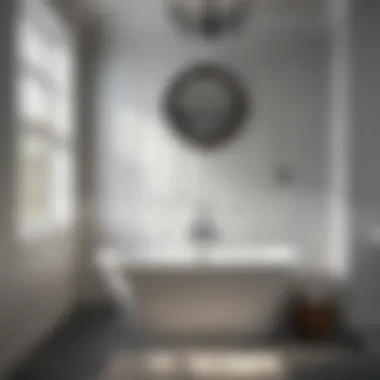

In summary, the way you light your wainscoted bathroom can be the straw that stirs the drink. Thoughtful placement and strategic use of lighting will not only enhance the wainscoting but also transform your bathroom into an elegant retreat where every detail shines.
Current Trends in Bathroom Design
In the ever-evolving world of interior design, bathrooms are becoming more than just functional spaces. The focus has shifted significantly towards aesthetics, comfort, and the clever play of design elements. This shift points to an important evolution in bathroom remodeling, particularly regarding how wainscoting fits into current bathroom trends.
The integration of wainscoting into bathroom design not only elevates the visual appeal but also speaks volumes about the homeowner's taste. Modern design sensibilities now lean towards a blend of various styles while maintaining a practical approach. With the rise of eco-friendly materials and the demand for multifunctional spaces, understanding current trends can unveil opportunities for homeowners to create serene retreats.
The intersection of functionality and style is where the true artistry of bathroom remodeling lies— especially when incorporating timeless elements like wainscoting. This is where it becomes essential to look at both the historical context and innovative trends that breathe life into today’s bathroom installations.
"Contemporary bathroom designs encourage personal expression, inviting moments of serenity wrapped in modern style."
Minimalism Meets Wainscoting
Minimalism is gaining popularity in recent years. It's all about stripping down to essentials, focusing on quality over quantity. When it comes to wainscoting, this minimalist approach invites a clean and streamlined aesthetic while offering a touch of sophistication. Homeowners are opting for simple designs, with bright colors and straight lines dominating the scene. Flat panel or beadboard wainscoting, in neutral tones, can make a small bathroom feel airy and open.
In a minimalist bathroom, wainscoting should not overpower the space. Instead, it should seamlessly integrate with the overall theme. Consider the following elements when blending minimalism with wainscoting:
- Color Choice: Light shades such as soft white or pale gray keep the space feeling expansive.
- Material Selection: Using materials that are durable yet simple can bridge functionality and aesthetic appeal. MDF offers a great lightweight option that is easy to maintain and paint.
- Clean Lines: The installation should emphasize the geometry of the room. A flat panel design will contribute to the tidy look that minimalist designs crave.
Vintage Aesthetics with Modern Touches
Conversely, mixing vintage charm with contemporary aspects creates an intriguing contrast that resonates well within the realm of bathroom design. Homeowners are increasingly drawn to vintage aesthetics as it adds warmth and a sense of history. Here, wainscoting can play a pivotal role, serving as a bridge between times.
Embracing vintage styles involves layering textures and colors, which makes wainscoting an ideal choice due to its versatile nature. Here are noteworthy ways to achieve this blend:
- Combination of Styles: Consider raised panel wainscoting, which offers a classic profile while pairing it with modern faucets and lighting. It creates a unique fusion of the old and the new.
- Color and Finish: Rich, warm stains on wood can enliven a modern bathroom, giving it personality. Pairing with distressed finishes can heighten the vintage effect.
- Accessorizing Smartly: Decorate with vintage green or porcelain elements, mixing with contemporary bold fixtures. This combination can effectively evoke nostalgia without sacrificing modern efficiency.
Budgeting for Your Bathroom Remodel
When venturing into a bathroom remodel, budgeting isn't just a box to check off. It's the backbone that guides every decision, ultimately influencing the aesthetic and functionality of the space. A well-thought-out budget ensures that you’re not left high and dry halfway through the project wishing you had allocated more for essential features. It’s all about striking the right balance between taste and financial prudence.
Before one digs in, it’s crucial to consider a few primary elements that can impact your overall costs: materials, labor, and unexpected expenses. Being proactive about these factors makes for smoother sailing.
Estimating Costs of Materials
Establishing a clear picture of material costs is essential. Wainscoting, for instance, comes in various materials, each with its own price range. Here’s a rough guide:
- Wood: While beautiful and classic, solid wood can be pricey. Expect around $3 to $10 per square foot, depending on species and finish.*
- MDF: A far more budget-friendly option, costs typically sit around $1 to $3 per square foot. It’s also easier to maintain in higher moisture areas.
- PVC: This one's a rising star in terms of durability. Pricing usually hovers around $2 to $4 per square foot.
Just remember, adding trim, paint, or a protective finish will add to the bill, so account for that in your calculations. Losing sight of these extras might just leave a dent in savings. Consider reaching out to local suppliers for specific estimates, as prices can fluctuate based on the economy or availability.
DIY vs. Professional Installation
The decision to roll up your sleeves or hire a professional can strongly affect both the budget and outcome of the project. Tackling the remodel as a DIY endeavor can feel empowering and save a pretty penny—but it has its challenges.
DIY Pros:
- Cost Savings: Naturally, doing it yourself means savings on labor costs.
- Customization: Take full control over design choices without having to go through a contractor.
DIY Cons:
- Skill Level: If you're not well-versed in home projects, underestimating your abilities can lead to costly mistakes.
- Time Investment: A DIY project may stretch out longer than anticipated, costing you in the form of inconvenience.
On the flip side, hiring a professional can ensure quicker and higher-quality work, but it's often a commitment that stretches the budget.
Professional Pros:
- Expertise: Access to knowledge and experience that often translates into sturdier, aesthetically pleasing results.
- Warranty: Many contractors offer warranties on workmanship, providing peace of mind.
Professional Cons:
- Higher Costs: Naturally, you’ll pay more upfront than for DIY.
- Limited Control: Once you hand over the reins, choices become guided by someone else’s vision.
When considering these options, weigh your own abilities against the complexity of the installation. If in doubt, consult with professionals or dive into DIY forums to gauge your decision.
"Budgeting may not be the flashiest aspect of a remodel, but it’s what turns a dream into reality. Remember to put pen to paper and keep tabs on every penny."
A clear and measured approach to budgeting can transform your bathroom into a stunning haven without breaking the bank. From estimating material costs to making informed decisions about installation, every choice counts toward maximizing both value and aesthetic appeal.
Final Thoughts on Wainscoting in Bathroom Design
As we pull back the curtain on bathroom remodeling with wainscoting, it’s crucial to take a moment and consider the implications of these design choices. Wainscoting is not merely an aesthetic addition; it weaves a tapestry of style, functionality, and personal touch that can elevate any bathroom. When you think about it, every decision made in shaping this private oasis has lasting impacts—both practically and emotionally.
The Importance of Wainscoting
Wainscoting softens the hard lines often found in bathrooms and introduces warmth, which can make your experience in a typically utilitarian space more comforting. With its range of styles—from ornate raised panels to sleek, modern shiplap—homeowners can tailor their bathroom appearance to reflect individual taste without compromising functionality.
Moreover, wainscoting has a practical side. Its material often proves to be durable and water-repellent, enhancing the lifespan of your surfaces against the daily wear and tear of humid environments. This marriage between beauty and pragmatism is part of what makes wainscoting so compelling.
"A bathroom isn’t just a place to get clean; it’s a personal retreat that should encourage relaxation and rejuvenation."
The Lasting Impact of Design Choices
When contemplating remodeling, especially with wainscoting, the past choices made in design become part of a chain reaction affecting the future of your space. Each aspect—from color selection to the style of wainscoting—plays a distinct role in setting the overall tone.
- Timeless Appeal: Certain wainscoting choices can resonate through time, ensuring that your updates hold up against fleeting trends. For example, opting for classic beadboard may give your bathroom a timeless coastal charm that remains favorable years down the road.
- Functionality and Durability: Not all design choices just serve to beautify. Selecting moisture-resistant materials for your wainscoting can provide long-term durability while maintaining aesthetic appeal, merging necessity with elegance.
- Emotional Resonance: Design isn’t just an exterior layer; it influences how you feel in a space. Bright colors or intricate designs might evoke joy or calm, creating an environment that is welcoming and supportive.
Encouraging Personal Expression through Design
Wainscoting offers a canvas for personal expression that can turn a mere bathroom into a reflection of your personality and lifestyle. It's a chance to infuse a little bit of




